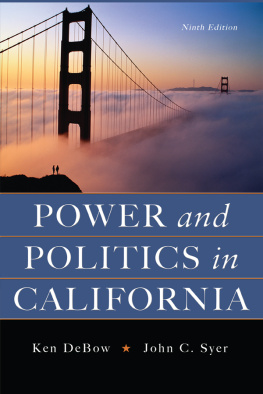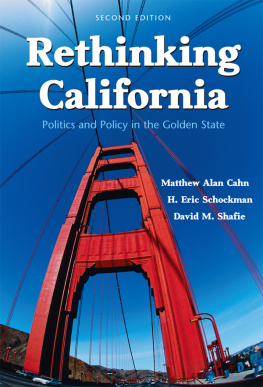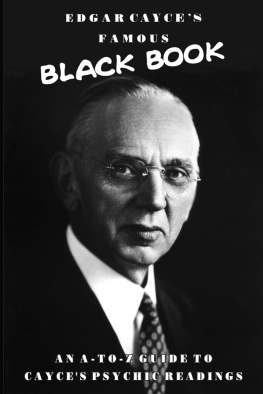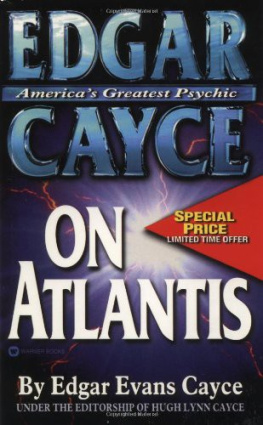CQ Press
1255 22nd Street, NW, Suite 400
Washington, DC 20037
Phone: 202-729-1900; toll-free, 1-866-4CQ-PRESS (1-866-427-7737)
Web: www.cqpress.com
Copyright 2008 by CQ Press, a division of Congressional Quarterly Inc.
All rights reserved. No part of this publication may be reproduced or transmitted in any form or by any means, electronic or mechanical, including photocopy, recording, or any information storage and retrieval system, without permission in writing from the publisher.
Cover design: Matthew Simmons, Myself Included Design
Cover photos: AP Images
Photos: 23, 90, 98, 102, AP Images; 43, San Diego Historical Society

The paper used in this publication exceeds the requirements of the American National Standard for Information SciencesPermanence of Paper for Printed Library Materials, ANSI Z39.48-1992.
Printed and bound in the United States of America
11 10 09 08 07 1 2 3 4 5
Preface
C alifornia is a state of immigrants. Among them my parents, who came to California as refugees after the Soviet Union occupied Estonia toward the end of World War II. My story, however, is somewhat different in that although I am Estonian by nationality and come from an immigrant family I was born in California and therefore also qualify as a native Californian. Writing this book comes from the experience of growing up in Southern California and trying to make sense of what has been happening to this state in the past thirty to forty years.
What has happened? Growth, growth, and more growth, pushed by a unified understanding on the part of virtually all economic and political leaders that we need growth and that the more development we get, the better off we will be. I grew up in Burbank and remember a time when there were still some farms in the San Fernando Valley, where Burbank is located. They were scruffy farms at that point, to be sure, but they still had orange and lemon trees; they grew corn; and it was not out of the ordinary to see chickens, goats, and horses. The last of those farms disappeared about the time that I was an undergraduate student at UCLA. By the time I moved thirty miles south to go to graduate school at the University of California, Irvine, I saw the last remnants of Orange Countys agricultural past also get plowed under. The orange and avocado groves disappeared, then the bean fields started to go, and finally the last strawberry fields that were still wedged between subdivisions were bulldozed and turned into tightly packed homes, big-box stores, and mini-malls. Between 1980 and the turn of the millennium, California added about ten million people to its population. But growth, it is repeated, is good.
Seeing these changesthe unbearable traffic, the strains that all these people place on resources like water, the sheer difficulty of figuring out just where to put everybodyled me to start thinking critically about the logic of growth and to question who really benefits from this unforgiving march of progress. Who are the we who benefit from growth? The answer can be found in Californias own rich history, a history that has been dominated by an economic, political, and cultural elite from its very earliest days. Property owners and business leaders have transformed California, but it is not a transformation that has benefited all of us. Quite the contrary. Economic power has used political and cultural power to create a power elite in California that has been remarkably proficient at generating profit and wealth for the few, while the rest of society is left to deal with the so-called externalities that growth inevitably produces. Whats a few extra cars on the road, and who cares that after it rains the ocean water is so laced with bacteria that the surfers risk getting sick? These are small prices to pay to be able to live in paradise. So we hold onto that image, while the reality all around us continues to change and becomes more dystopian than utopian.
California politics is about the power elite. Unlike textbooks that insist that democracy matters and that the system might be flawed but ultimately can be fixed, this book takes the approach that the states political structure has to be analyzed as a system by and for the rich. It is a plutocracy, supported by a political system that has been hopelesslyat least in its present configurationbought off by the ruling economic class through the injection of enormous amounts of money into the campaign process, reinforced later by millions of dollars spent on lobbying by corporations and a select few organizations that want something for themselves, not for us.
In this text students do learn about the states political history and its institutionshow its parties work, how the legislature operates, what powers its governors have, how its budget is formulatedbut this information does not obscure the many ways that those institutions and the people that run them hinder, rather than facilitate, basic democratic practices and goals. In a nutshell, this is not a book that seeks a so-called balanced approach to understanding California politics. There is no balance and fairness when the power elite decide what is to be done and the public, in turn, is left to react to decisions already made. Moreover, the power elites hold on power is getting stronger, as evidenced by the growing gap between the rich and poor in this state. For immigrants coming today, California is not a place of hope. There are no hills full of gold; this is just another place for survival.
Structure of the Book
Elite politics and the limits placed on democracy are not just part of California politics but are rooted in all of American politics. That is the main argument presented in the Introduction and interests that have used these growth machines to increase wealthand cheap immigrant labor to keep costs down and profits up.
The actual institutional structures of California politics are the focus of . When land use needs to be revitalized, redevelopment agencies serve as an arm of growth machines to funnel public money to private development interests.
The fear of taxation has created a kind of permanent economic crisis in California, the theme of focuses on the long-term outlook for the state, which includes the possibility that global warming might dramatically and suddenly change Californians way of life completely.
Key Features
This is not a text for memorizing what each public official must do and how many legislators there are in the state assembly. (There are eighty, if you must know right now.) It does offer these basics, but, more important, the book goes another step in developing students critical thinking skills. If democracy is ever going to become truly democratic, students need to be able to understand what real criticism entails. The pedagogical features used here are designed to help students acquire some new terminology and think critically about what theyre learning. Key terms that are specific to this discussion appear in boldface type throughout the chapters, and the book features a glossary that further defines them. At the end of each chapter, readers will find a section called Taking Stock that encapsulates that chapters analysis. These sections highlight the main themes of each chapter, integrating the parts of the story into a thematic whole. Discussion questions at the end of each chapter are intended to spark debate. Students will find a comprehensive list of research tools at the end of the book in an appendix called For Further Research. These tools include books, articles, essays, online databases, blogs, and other kinds of scholarship and commentary, organized by type.

 The paper used in this publication exceeds the requirements of the American National Standard for Information SciencesPermanence of Paper for Printed Library Materials, ANSI Z39.48-1992.
The paper used in this publication exceeds the requirements of the American National Standard for Information SciencesPermanence of Paper for Printed Library Materials, ANSI Z39.48-1992.








